March 2015
ERNEST DUBE, WILLEM KILIAN, BEN VAN RENSBURG, MANUS VAN DER MERWE, ELSA VAN DER MERWE and HESTA HATTING, ARC- SMALL GRAIN INSTITUTE, BETHLEHEM
Profitability of wheat farming in South Africa is dependent on the continued adoption and deployment of new varieties with superior yield and disease resistance characteristics. For many years, irrigation wheat producers in South Africa have relied upon the annual National Wheat Cultivar Evaluation Programme for continued delivery of independent and accurate information on the performance of both new and old wheat varieties. The 2014/2015 season was fantastic for irrigation wheat as producers obtained high yields. This was not only due to the favourable climate conditions for irrigation wheat during the entire wheat season, but also because of the availability of high yielding irrigation wheat cultivars that are adapted to various production regions.
Irrigation wheat cultivar evaluation trials for 2015 were carried out in the cooler central irrigation areas, the warmer northern irrigation areas, KwaZulu-Natal and the Eastern Highveld. The results of the 2014 cultivar trials under irrigation were presented to the National Wheat Cultivar Evaluation Workgroup on 12 February 2015. The report was accepted and the new recommendations for the 2015 season were finalised. In the following section, the yields of early planted irrigation cultivars are presented. Four year average yields for the cultivars are also provided to give an indication of the yield stability.
Cultivar evaluation results
Cooler central irrigation areas
The average yield for the first plantings in the cooler central irrigation areas in 2014 was 8,36 tons/ha. From the combined analysis for the first plantings, SST 895 (9,01 tons/ha), SST 884 (8,95 tons/ha), SST 806 (8,90 tons/ha) and SST 835 (8,86 tons/ha) produced the highest yields (Table 1). Average hectolitre mass was very high in 2014, at 80,36 kg/hl. All cultivars graded above 77 kg/hl. Average grain protein content was good in 2014 (12,71%), and better than 2013, which had 12,17%. The average protein content for all cultivars was above 12%, except for Krokodil. Falling number values were generally high, with a combined average of 354 seconds. The four year average grain yields indicate that SST 806 and SST 835 produced the highest yield (9,97 tons/ha), followed by SST 884 (9,87 tons/ha) and PAN 3471 (9,85 tons/ha) (Graph 1). It should be noted that the yields of these four cultivars were not significantly different from each other.
Warmer northern irrigation areas
The average yield for the first plantings in 2014 was 8,25 tons/ha and this was better than that of 2013 which was 7,04 tons/ha. From the combined analysis for the first plantings, SST 806 (9,04 tons/ha), PAN 3497 (8,87 tons/ha) and SST 866 (8,86 tons/ha) had the highest yields (Table 2). The average hectolitre mass was very high at 81,77 kg/hl, and slightly better than that of 2013 (80,75 kg/hl). All cultivars graded above 80 kg/hl. Average grain protein content was, however, very low in 2014 (10,32%), although better than 2013, which had 10,04%. SST 843 had the highest average protein content (12,35%), followed by PAN 3623 (11,32%) and SST 884 (10,50%). Falling number values were generally high, with a combined average of 382 seconds. It should be noted that the yields of the first three cultivars were not significantly different from each other, statistically. The four year average grain yields indicate that SST 806 produced the highest yield (7,98 tons/ha), followed by SST 895 (7,86 tons/ha) and SST 884 (7,77 tons/ha) (Graph 2).
Eastern Highveld irrigation areas
The average yield for the first plantings in 2014 was 8,22 tons/ha and this was slightly better than that of 2013, which was 7,98 tons/ha. From the combined analysis for the first plantings, SST 884 (8,86 tons/ha), SST 875 (8,76 tons/ha), SST 835 (8,47 tons/ha) and PAN 3489 (8,47 tons/ha) had the highest yields (Table 3). Average hectolitre mass was very high at 81,76 kg/hl, and slightly better than that of 2013 (80,77 kg/hl). All cultivars graded above 77 kg/hl. The average grain protein content was good in 2014 (12,25%), and better than 2013, which had 11,87%. SST 843 had the highest average protein content (13,27%), followed by PAN 3623 (12,50%) and SST 867 (12,45%). Falling number values were generally high, with a combined average of 349 seconds. The three year average grain yields indicate that SST 835 produced the highest yield (8,61 tons/ha), followed by PAN 3471 (8,36 tons/ha) and SST 875 (8,54 tons/ha) (Graph 3). The yields of these four cultivars were not significantly different from each other.
KwaZulu-Natal irrigation areas
The average yield over localities and cultivars in 2014 was 6,99 tons/ha. From the combined analysis, SST 835 (7,86 tons/ha), SST 806 (7,79 tons/ha), PAN 3489 (7,53 tons/ha) and PAN 3471 (7,53 tons/ha) had the highest yields (Table 4). Hectolitre mass values for 2014 were very high for most cultivars, with an average of 82,29 kg/hl. All cultivars had a hectolitre mass that was above 80 kg/hl. Grain protein content was also good during 2014 at 12,38%. Falling number values were generally high, with an average of 285 seconds for cultivars and localities combined. The yields of these top four cultivars were not statistically significant from each other. The four year average grain yields indicate that SST 806 (8,28 tons/ha) produced the highest yield, followed by SST 835 (8,21 tons/ha) and Krokodil (8,03 tons/ha) (Graph 4).
More detailed information on the performance of irrigation wheat cultivars, including data on the one year performance as well as the long-term data for all the production regions and different planting times, are available in the Production Guidelines published by the ARC-Small Grain Institute. These guidelines are being distributed to all small grain producers. Contact the ARC-Small Grain Institute at 058 307 3400.
The research was made possible through funding by the
Winter Cereal Trust and the Agricultural Research Council.
Publication: March 2015
Section: Annexe





















